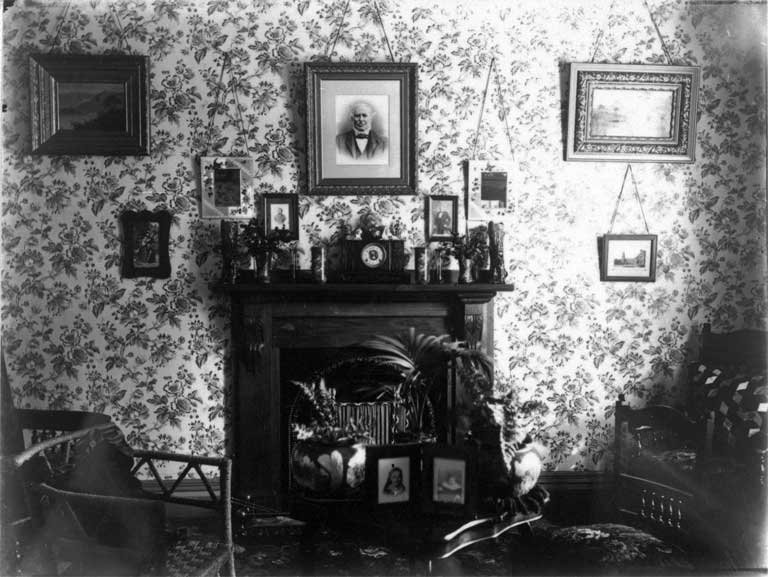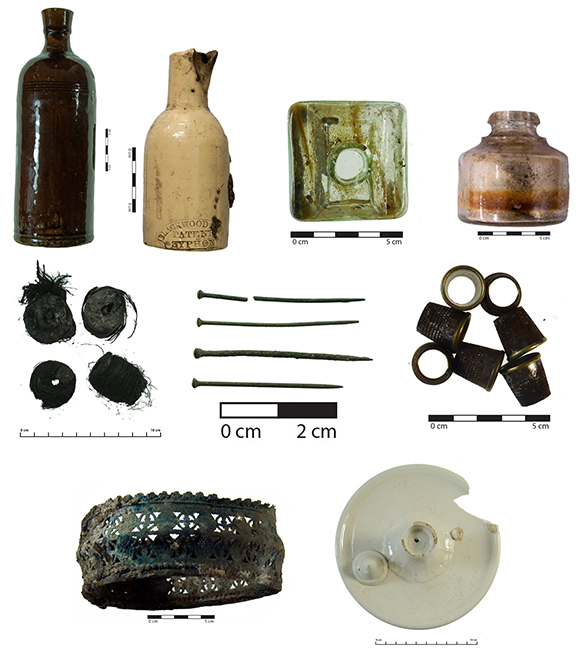And so, from the hall, to the parlour, the ‘best’ room in the house and, in more wealthy circles, known as the drawing room. As an aside, these naming schemes fascinate me – at exactly what point (in the social/wealth scheme) did a parlour become a drawing room? And when and where and why do sitting rooms, living rooms and lounges come into the picture, particularly in Aotearoa New Zealand? And how do breakfast and morning rooms fit into the picture? More importantly, what do these name changes tell us about what’s going on in society and domestic life at a broader level?

But back to James and Priscilla’s parlour. Or maybe that should be, Priscilla and James’s parlour. The drawing room in Victorian Britain, with its ‘upper’ (used here to refer to both the upper middle and upper classes) class associations, and consequently with a class that employed servants, is generally considered to have been a feminine room, and one where women spent much of their day, reading, sewing, entertaining guests and organising their household (Tange 2010: 62). To what extent this was true of the parlour in late 19th century Aotearoa New Zealand is not clear, particularly in the case of Priscilla and her daughter Margaret, who may not have employed a servant, meaning that they may not have had a great deal of time for relaxing in the parlour during the day.

The identification of the parlour/drawing room as a feminine space was a key part of the middle class ideology of separate spheres discussed in the previous post. This room was where the women of the house would entertain their friends, and it was thus the most important room in the house for displaying their respectability and taste. As part of this, the parlour/drawing room showed how a woman created a beautiful, tasteful and relaxing sanctuary from the torments of the public world for her poor hard-working husband… Which completely ignores all the hard work that would have gone into creating this space, keeping the house clean and tidy, looking after children, preparing the meals, and doing the shopping, all whilst appearing suitably respectable – and calm. Anyway. The parlour, though, was not just used for entertaining, it was also used by the family as a space to relax together.
The parlour, then, was the most decorative and decorated room in the house. It was also usually the most prominent and Priscilla’s parlour was a classic example of this, with its protruding bay and bay window – so it would have been clear to passersby that this was the parlour. The room had a fireplace, in order to provide cheer and – maybe – some warmth. The fireplace was also an important place for display, in the form of the mantelpiece itself (which also provided a place for displaying goods), the fire surround (some were tiled, although the Chalmers’s one was not) and the tiles on the hearth (which had been removed in this instance). There was little else in the way of built-in decoration in this parlour – no ceiling or cornice and no picture rail to hang pictures from (although such things could have been removed latterly). The walls, though, were no doubt originally covered in a decorative wallpaper.

Decorative objects would have played a role in the construction of this space, things like ornaments, vases, decorative lamps, well-chosen and placed furniture, as well as hung pictures and fabric coverings. Sketches and photographs of contemporary parlours (themselves a performance that probably didn’t quite equal reality – I’m sure that the rooms shown in modern interior design never look quite that tidy in everyday use) even show decorative or ornamental plants placed about the room, not so dissimilar to today.


Within this space, James and – especially – Priscilla, would have entertained and hosted guests with the aid of their material culture, particularly through the rituals of tea-drinking and, perhaps, alcohol consumption. The taking of tea involved in the full performance of afternoon or morning tea was not, as I suspect most of us do it now, limited to a teabag, a cup and some boiling water, but instead tea in a teapot, with matching milk jug, sugar bowl, teacups, saucers and, perhaps, even side places for the accompanying snacks.


At a different time of day, or in different company, the tea service may have been switched out for alcohol, and the Chalmers may have used glass sets of decanters and tumblers to serve their guests. Glass or ceramic dishes may have been used to set out sweets, delicacies or snacks. The parlour may have also been wreathed in smoke, from time to time, if James, Priscilla (unlikely) or their guests smoked a pipe, or – by the early 20th century – cigarettes. It’s just as likely, however, that smoking wasn’t an activity that took place in the parlour – it may instead have been restricted to the dining room, as a more ‘masculine’ space (see following posts).

Games may have been played through the course of this entertaining. ‘Parlour games’ is still a phrase we know and one that was often used in the 19th and early 20th century to mean a more lewd, less socially appropriate activity. Nevertheless, games were absolutely a part of the function of a parlour, both in its role as a space for guests and within the privacy of the family sphere. Games like dominoes, for example, may have been played by children and adults alike. There’s no evidence to suggest that James and Priscilla had a piano, but musical performances and practice may also have fallen within the use of this particular room.

It’s important to remember that the parlour was not a space that was only used when guests were present. It would also have functioned as a space of work and leisure for the family in private. James and Priscilla may have had a writing desk, for example, at which they wrote letters or carried out professional or personal projects. We know that James was a member of multiple associations, including those dedicated to improving the lot of the working class – perhaps this room is where he wrote and read towards those efforts. For Priscilla, the parlour is also the room in which she’s likely to have done needlework – engaging in that ‘genteel’ domestic industry. The bay window would have provided sufficient light during the day to carry out such work and, in the evenings, if the room was well lit (lamps again! – they’re going to be a feature of every room), the fireplace, lamps and candles would have made the room bright enough to continue.

Katharine & Jessie
References
Tange, Andrea Kaston. Architectural Identities: Domesticity, Literature and the Victorian Middle Classes. Toronto: University of Toronto Press, 2010. doi:10.3138/j.ctt2ttkx9.
